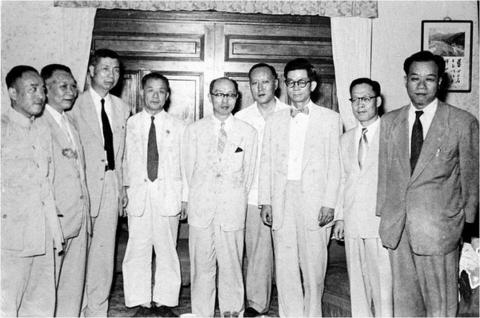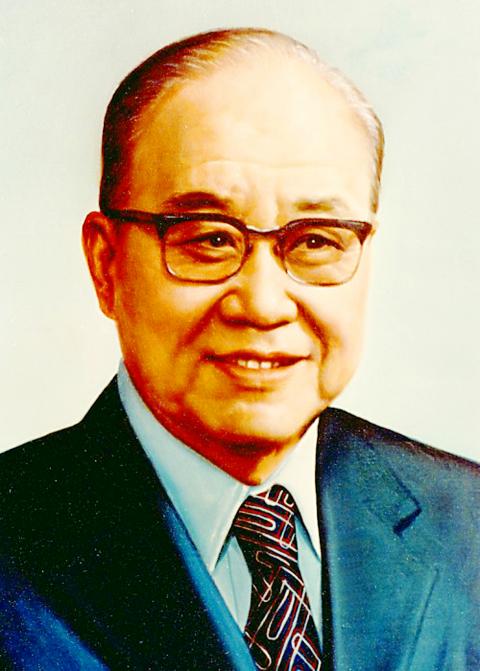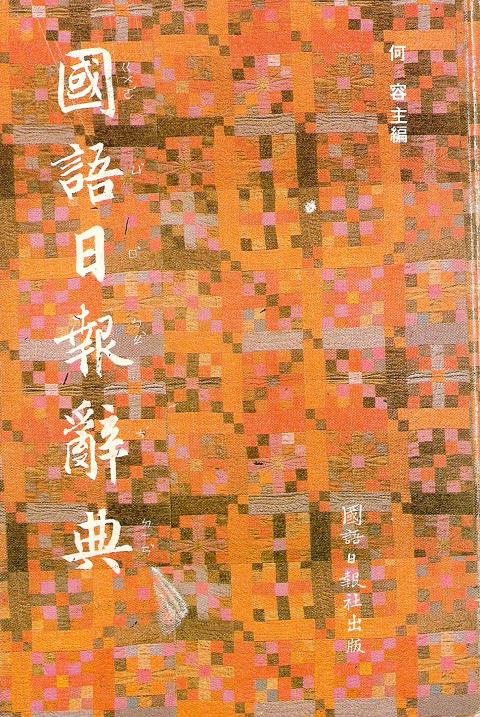Oct. 7 to OCT. 13
Hsieh Tung-min (謝東閔) didn’t think too much when he received a dictionary in the mail. But as soon as he opened it, the book exploded, shattering the windows in his room and collapsing the ceiling. He was rushed to the hospital, where the doctors amputated his left hand and his right ring finger.
It was Oct. 10, 1976, and Hsieh had just returned home from observing the Double Ten celebrations and inspecting the newly-completed Huazhong Bridge (華中橋).

Photo courtesy of Wikimedia Commons
“I did not feel hateful, I just lamented that I wasn’t careful enough. What I cared about most is that our stable and prosperous base to reclaim [China] did not suffer any more damage,” Hsieh writes in his memoir. “I did not think of resigning because that would make me look like a coward. Also, I still had many aspirations.”
Hsieh wasn’t the only government official to be letterbombed. China Youth Corps chairman Lee Huan (李煥) also lost a finger, while General Huang Chieh (黃杰) narrowly escaped after a warning from Lee. It was later found that the culprit was Wang Sing-nan (王幸男), a Taiwanese businessman residing in the US.
Two years later, Hsieh became Taiwan’s vice-president under Chiang Ching-kuo (蔣經國) — the highest post ever achieved by a Taiwan-born politician at that time after more than three decades of Chinese Nationalist Party (KMT) rule.

Photo courtesy of Wikimedia Commons
While Hsieh was part of Chiang’s policy to promote more Taiwanese politicians, including former president Lee Teng-hui (李登輝), the independence activists saw him as a traitor for working with the authoritarian government.
‘HALF MOUNTAIN’
Hsieh was what they called a banshan (半山, “half mountain”) in those days — a Taiwanese who spent significant time in China and returned with the KMT after the Chinese Civil War. Born in Changhua County in 1908, Hsieh witnessed Japanese brutality towards Taiwanese from a young age. In his memoir, he details the various injustices that led him to resent the Japanese and strongly identify with the “motherland” of China.

Photo courtesy of Wikimedia Commons
Tired of being treated as a second-class citizen, Hsieh headed to Shanghai to study when he was 17 years old, vowing not to return home as long as the Japanese ruled Taiwan. In 1930, during his last year of university, Hsieh joined the KMT after deciding that its “Three Principles of the People” fit China’s needs the best.
During World War II, Hsieh was a key part of the KMT’s preparatory efforts to spread its influence in Taiwan once the Japanese surrendered. At the National Assembly in May 1945, Hsieh urged the KMT to use as many Taiwanese as possible once they took over in order to connect better with the populace; obviously that suggestion was not heeded. After 20 years in China, he finally arrived home on Oct. 24, 1945.
Hsieh had planned to assist the KMT culturally by teaching Mandarin and promoting Chinese culture and history, but governor-general Chen Yi (陳儀) ordered him to serve as Kaohsiung County’s first commissioner.
It seems that Hsieh was a capable official who genuinely cared about the people and desired to improve the nation as he rose through the ranks. But given his position and the year the memoir was published (1988), it completely follows the official narrative of that time: Taiwan was a democratic nation, and the White Terror didn’t exist. The 228 Incident, an anti-government uprising in 1947, is never mentioned.
One of Hsieh’s lasting contributions was advocating vocational education — leading to the birth of today’s National Taiwan University of Sport, National Taiwan University of Arts and Shih Chien University, which he personally founded in 1958 as Shih Chien School of Home Economics.
To boost the economy, Hsieh promoted the home-manufacturing movement under the slogan “turn your living room into a factory,” leading to many products worldwide carrying the famous “Made in Taiwan” stickers.
POLAR OPPOSITES
Chiang’s choice of Hsieh as his first vice-president is seen as the beginning of his tendency to promote Taiwan-born politicians. But Hsieh’s idealistic view of harmonious relations between Taiwan-born and Chinese-born citizens seemed rather delusional — again, this could just be official speak. Regarding his “bid” for vice-president (both he and Chiang ran unopposed), he writes in his memoir:
“Some of my friends were worried that since I was born in Taiwan, it would be difficult for me to garner the support of National Assembly members from different provinces. I don’t think that should be a concern. Everybody who lives on this [island] originally came from China … Over the past 30 years, the ones who came first and those who came after 1945 have fully integrated, working together to build Taiwan as a prosperous paradise to propagate the Three Principles of the People. There is absolutely no ‘us’ and ‘them.’”
Any form of violence should not be condoned, but it’s important to consider the point of view of Wang, the man who sent the bomb. Born in 1941, Wang attended the Republic of China Military Academy and fully believed in the KMT propaganda until he was discharged in 1970. He subsequently headed to the US to study. Free of government censorship, he started learning about the 228 Incident and the attempt to assassinate Chiang, and questioned his unwavering belief in “reclaiming the mainland.”
“Under the KMT, I believed that anybody who opposed the government was a bad person. I was taught that the KMT took care of the people and was a party that showed great leadership. Only when I arrived in the US did I realized that not only was I lied to, I was lied to for so many years. I became very angry,” Wang says in an oral history collection of independence activists published by Academia Sinica.
Regarding his bombing attempt: “I felt that reform would never come in Taiwan, and that a more extreme revolution was needed,” claiming inspiration from incidents in Palestine and Northern Ireland. “I wanted to let the KMT know how angry the Taiwanese were.”
Why did he target Hsieh? “He is a Taiwanese, and he held such a high position in the government, but he never spoke out on behalf of the Taiwanese. That’s why I chose him.”
Taiwan in Time, a column about Taiwan’s history that is published every Sunday, spotlights important or interesting events around the nation that have anniversaries this week.

This month the government ordered a one-year block of Xiaohongshu (小紅書) or Rednote, a Chinese social media platform with more than 3 million users in Taiwan. The government pointed to widespread fraud activity on the platform, along with cybersecurity failures. Officials said that they had reached out to the company and asked it to change. However, they received no response. The pro-China parties, the Chinese Nationalist Party (KMT) and Taiwan People’s Party (TPP), immediately swung into action, denouncing the ban as an attack on free speech. This “free speech” claim was then echoed by the People’s Republic of China (PRC),

Exceptions to the rule are sometimes revealing. For a brief few years, there was an emerging ideological split between the Democratic Progressive Party (DPP) and Chinese Nationalist Party (KMT) that appeared to be pushing the DPP in a direction that would be considered more liberal, and the KMT more conservative. In the previous column, “The KMT-DPP’s bureaucrat-led developmental state” (Dec. 11, page 12), we examined how Taiwan’s democratic system developed, and how both the two main parties largely accepted a similar consensus on how Taiwan should be run domestically and did not split along the left-right lines more familiar in

Specialty sandwiches loaded with the contents of an entire charcuterie board, overflowing with sauces, creams and all manner of creative add-ons, is perhaps one of the biggest global food trends of this year. From London to New York, lines form down the block for mortadella, burrata, pistachio and more stuffed between slices of fresh sourdough, rye or focaccia. To try the trend in Taipei, Munchies Mafia is for sure the spot — could this be the best sandwich in town? Carlos from Spain and Sergio from Mexico opened this spot just seven months ago. The two met working in the

Many people in Taiwan first learned about universal basic income (UBI) — the idea that the government should provide regular, no-strings-attached payments to each citizen — in 2019. While seeking the Democratic nomination for the 2020 US presidential election, Andrew Yang, a politician of Taiwanese descent, said that, if elected, he’d institute a UBI of US$1,000 per month to “get the economic boot off of people’s throats, allowing them to lift their heads up, breathe, and get excited for the future.” His campaign petered out, but the concept of UBI hasn’t gone away. Throughout the industrialized world, there are fears that